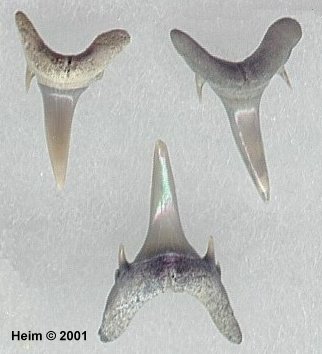Odontaspis reticulata (PROBST, 1879)
The teeth have long lateral and often doubled cusplets and possess a delicate, slender main cusp.
These teeth are defined as being very similar to the Odontaspis-design except
possessing fine striations on the blade.
Generally, Odontaspis teeth differ from Carcharias by having the doubled cusplets more separated and often having a third cusplet as well.
What these teeth appear even more similar to are those of the modern taxa, Odontaspis noronhai (MAUL, 1955) a little known and rarely seen shark of the deep ocean.
Kent (1994) separated C. reticulata from Odontaspis "by the possession
of nearly complete cutting edges and very weak striations on the lingual face of the crown".
Purdy et al (2001) convincingly reassigned these teeth to Odontaspis but unconvincingly to the species acutissima.
 |
Fig. 1 - Odontaspis cf reticulata
lingual view of Pungo River specimens,
The largest tooth in this image is 21mm long. |